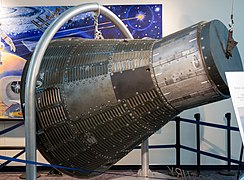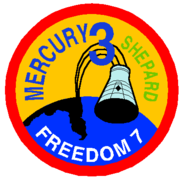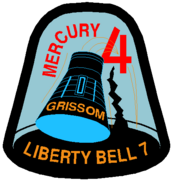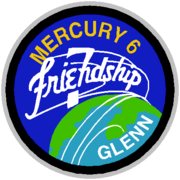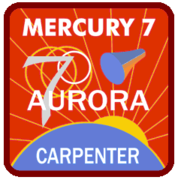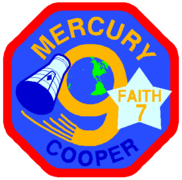Project Mercury
Cape Canaveral | |
| Vehicle information | |
|---|---|
| Crewed vehicle(s) | Mercury capsule |
| Launch vehicle(s) | |
| Part of a series on the |
| United States space program |
|---|
  |
Project Mercury was the first
The Space Race began with the 1957 launch of the Soviet
The Mercury
The Mercury project gained popularity, and its missions were followed by millions on radio and TV around the world. Its success laid the groundwork for Project Gemini, which carried two astronauts in each capsule and perfected space docking maneuvers essential for crewed lunar landings in the subsequent Apollo program announced a few weeks after the first crewed Mercury flight.
Creation
Project Mercury was officially approved on October 7, 1958, and publicly announced on December 17.
Background
Following the end of World War II, a nuclear arms race evolved between the US and the Soviet Union (USSR). Since the USSR did not have bases in the western hemisphere from which to deploy bomber planes, Joseph Stalin decided to develop intercontinental ballistic missiles, which drove a missile race.[10] The rocket technology in turn enabled both sides to develop Earth-orbiting satellites for communications, and gathering weather data and intelligence.[11] Americans were shocked when the Soviet Union placed the first satellite into orbit in October 1957, leading to a growing fear that the US was falling into a "missile gap".[12][11] A month later, the Soviets launched Sputnik 2, carrying a dog into orbit. Though the animal was not recovered alive, it was obvious their goal was human spaceflight.[13] Unable to disclose details of military space projects, President Eisenhower ordered the creation of a civilian space agency in charge of civilian and scientific space exploration. Based on the federal research agency National Advisory Committee for Aeronautics (NACA), it was named the National Aeronautics and Space Administration (NASA).[14] The agency achieved its first goal of launching a satellite into space, the Pioneer 1, in 1958. The next goal was to put a man there.[15]
The limit of space (also known as the Kármán line) was defined at the time as a minimum altitude of 62 mi (100 km), and the only way to reach it was by using rocket-powered boosters.[16][17] This created risks for the pilot, including explosion, high g-forces and vibrations during lift off through a dense atmosphere,[18] and temperatures of more than 10,000 °F (5,500 °C) from air compression during reentry.[19]
In space, pilots would require pressurized chambers or
Organization
Contractors and facilities
Twelve companies bid to build the Mercury spacecraft on a $20 million ($209 million adjusted for inflation) contract.
-
Wallops Island test facility, 1961
-
Mercury Control Center, Cape Canaveral, 1963
-
Location of production and operational facilities of Project Mercury
Spacecraft
The Mercury spacecraft's principal designer was Maxime Faget, who started research for human spaceflight during the time of the NACA.[47] It was 10.8 feet (3.3 m) long and 6.0 feet (1.8 m) wide; with the launch escape system added, the overall length was 25.9 feet (7.9 m).[48] With 100 cubic feet (2.8 m3) of habitable volume, the capsule was just large enough for a single crew member.[49] Inside were 120 controls: 55 electrical switches, 30 fuses and 35 mechanical levers.[50] The heaviest spacecraft, Mercury-Atlas 9, weighed 3,000 pounds (1,400 kg) fully loaded.[51] Its outer skin was made of René 41, a nickel alloy able to withstand high temperatures.[52]
The spacecraft was cone shaped, with a neck at the narrow end.[48] It had a convex base, which carried a heat shield (Item 2 in the diagram below)[53] consisting of an aluminum honeycomb covered with multiple layers of fiberglass.[54] Strapped to it was a retropack (1)[55] consisting of three rockets deployed to brake the spacecraft during reentry.[56] Between these were three minor rockets for separating the spacecraft from the launch vehicle at orbital insertion.[57] The straps that held the package could be severed when it was no longer needed.[58] Next to the heat shield was the pressurized crew compartment (3).[59] Inside, an astronaut would be strapped to a form-fitting seat with instruments in front of him and with his back to the heat shield.[60] Underneath the seat was the environmental control system supplying oxygen and heat,[61] scrubbing the air of CO2, vapor and odors, and (on orbital flights) collecting urine.[62] The recovery compartment (4)[63] at the narrow end of the spacecraft contained three parachutes: a drogue to stabilize free fall and two main chutes, a primary and reserve.[64] Between the heat shield and inner wall of the crew compartment was a landing skirt, deployed by letting down the heat shield before landing.[65] On top of the recovery compartment was the antenna section (5)[66] containing both antennas for communication and scanners for guiding spacecraft orientation.[67] Attached was a flap used to ensure the spacecraft was faced heat shield first during reentry.[68] A launch escape system (6) was mounted to the narrow end of the spacecraft[69] containing three small solid-fueled rockets which could be fired briefly in a launch failure to separate the capsule safely from its booster. It would deploy the capsule's parachute for a landing nearby at sea.[70] (See also Mission profile for details.)
The Mercury spacecraft did not have an on-board computer, instead relying on all computation for reentry to be calculated by computers on the ground, with their results (retrofire times and firing attitude) then transmitted to the spacecraft by radio while in flight.[71][72] All computer systems used in the Mercury space program were housed in NASA facilities on Earth.[71] (See Ground control for details.)
-
1. Retropack. 2. Heatshield. 3. Crew compartment. 4. Recovery compartment. 5. Antenna section. 6. Launch escape system.
-
Retropack: Retrorockets with red posigrade rockets
-
Landing skirt (or bag) deployment: skirt is inflated; on impact the air is pressed out (like an airbag)
Pilot accommodations

The astronaut lay in a sitting position with his back to the heat shield, which was found to be the position that best enabled a human to withstand the high g-forces of launch and reentry. A fiberglass seat was custom-molded from each astronaut's space-suited body for maximum support. Near his left hand was a manual abort handle to activate the launch escape system if necessary prior to or during liftoff, in case the automatic trigger failed.[73]
To supplement the onboard environmental control system, he wore a pressure suit with its own oxygen supply, which would also cool him.[74] A cabin atmosphere of pure oxygen at a low pressure of 5.5 psi or 38 kPa (equivalent to an altitude of 24,800 feet or 7,600 metres) was chosen, rather than one with the same composition as air (nitrogen/oxygen) at sea level.[75] This was easier to control,[76] avoided the risk of decompression sickness ("the bends"),[77][n 6] and also saved on spacecraft weight. Fires (which never occurred during the course of Project Mercury) would have to be extinguished by emptying the cabin of oxygen.[62] In such case, or failure of the cabin pressure for any reason, the astronaut could make an emergency return to Earth, relying on his suit for survival.[78][62] The astronauts normally flew with their visor up, which meant that the suit was not inflated.[62] With the visor down and the suit inflated, the astronaut could only reach the side and bottom panels, where vital buttons and handles were placed.[79]
The astronaut also wore
Despite the lessons learnt from the U2 program, which also utilized a pressure suit, initially no urine collection device was included for the Mercury astronauts. An inquiry on the subject was made in February 1961 by a student, but NASA responded by stating that "the first space man is not expected to have 'to go".[83] The expected short flight times meant that this was overlooked, although after Alan Shepard had a launch delay of four hours, he was forced to urinate in his suit, short-circuiting some of the electrodes monitoring his vital signs. Gus Grissom wore two rubber pants on the second Mercury flight as a crude workaround. It would take until the third flight in February 1962 before a dedicated urine collection device was installed.[84]
Once in orbit, the spacecraft could be rotated in
The Mercury astronauts had taken part in the development of their spacecraft, and insisted that manual control, and a window, be elements of its design.[89] As a result, spacecraft movement and other functions could be controlled three ways: remotely from the ground when passing over a ground station, automatically guided by onboard instruments, or manually by the astronaut, who could replace or override the two other methods. Experience validated the astronauts' insistence on manual controls. Without them, Gordon Cooper's manual reentry during the last flight would not have been possible.[90]
- Spacecraft cutaway
-
Interior of spacecraft
-
The three axes of rotation for the spacecraft: yaw, pitch and roll
-
Temperature profile for spacecraft in Fahrenheit
- Control panels and handle
-
The control panels of Friendship 7.[91] The panels changed between flights, among others the periscope screen that dominates the center of these panels was dropped for the final flight together with the periscope itself.
-
3-axis handle for attitude control
Development and production
The Mercury spacecraft design was modified three times by NASA between 1958 and 1959.
The spacecraft were produced at
-
Evolution of capsule design, 1958–59
-
Experiment with boilerplate spacecraft, 1959
-
Drop of boilerplate spacecraft in training of landing and recovery. 56 such qualification tests were made together with tests of individual steps of the system.[44]
Launch vehicles
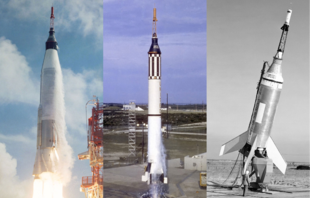
Launch escape system testing
A 55-foot-long (17 m) launch vehicle called
Suborbital flight
The
Orbital flight
Orbital missions required use of the Atlas LV-3B, a man-rated version of the Atlas D which was originally developed as the United States' first operational intercontinental ballistic missile (ICBM)[131] by Convair for the Air Force during the mid-1950s.[132] The Atlas was a "one-and-one-half-stage" rocket fueled by kerosene and liquid oxygen (LOX).[131] The rocket by itself stood 67 feet (20 m) high; total height of the Atlas-Mercury space vehicle at launch was 95 feet (29 m).[133]
The Atlas first stage was a booster skirt with two engines burning liquid fuel.[134][n 12] This, together with the larger sustainer second stage, gave it sufficient power to launch a Mercury spacecraft into orbit.[131] Both stages fired from lift-off with the thrust from the second stage sustainer engine passing through an opening in the first stage. After separation from the first stage, the sustainer stage continued alone. The sustainer also steered the rocket by thrusters guided by gyroscopes.[135] Smaller vernier rockets were added on its sides for precise control of maneuvers.[131]
Gallery
-
Little Joe assembling at Wallops Island
-
Erection of Redstone atLaunch Complex 5
-
Unloading Atlas at Cape Canaveral
-
Atlas - with spacecraft mounted - on launch pad at Launch Complex 14
Astronauts

NASA announced the following seven astronauts – known as the Mercury Seven – on April 9, 1959:[136][137]
| Name | Launch | Rank | Unit | Born | Died |
|---|---|---|---|---|---|
M. Scott Carpenter
|
1962/5/24 | Lieutenant | USN | 1925 | 2013 |
L. Gordon Cooper
|
1963/5/15 | Captain | USAF | 1927 | 2004 |
John H. Glenn, Jr.
|
1962/2/20 | Major | USMC | 1921 | 2016 |
Virgil I. Grissom
|
1961/7/21 | Captain | USAF | 1926 | 1967 |
Walter M. Schirra, Jr.
|
1962/10/3 | Lt Commander | USN | 1923 | 2007 |
Alan B. Shepard, Jr.
|
1961/5/5 | Lt Commander | USN | 1923 | 1998 |
Donald K. Slayton
|
Major | USAF | 1924 | 1993 |
Alan Shepard became the first American in space by making a suborbital flight on May 5, 1961.[138] Mercury-Redstone 3, Shepard's 15 minute and 28 second flight of the Freedom 7 capsule demonstrated the ability to withstand the high g-forces of launch and atmospheric re-entry. Shepard later went on to fly in the Apollo program and became the only Mercury astronaut to walk on the Moon on Apollo 14.[139][140]
Gus Grissom became the second American in space on Mercury-Redstone 4 on July 21, 1961. After the splashdown of Liberty Bell 7, the side hatch opened and caused the capsule to sink although Grissom was able to be safely recovered. His flight also gave NASA the confidence to move on to orbital flights. Grissom went on to participate in the Gemini and Apollo programs, but died in January 1967 during a pre-launch test for Apollo 1.[141][142]
John Glenn became the first American to orbit the Earth on Mercury-Atlas 6 February 20, 1962. During the flight, the spacecraft Friendship 7 experienced issues with its automatic control system but Glenn was able to manually control the spacecraft's attitude. He quit NASA in 1964, when he came to the conclusion that he likely would not be selected for any Apollo missions, and was later elected to the US Senate, serving from 1974 to 1999. During his tenure, he returned to space in 1998 as a Payload Specialist aboard STS-95.[143][144]
Scott Carpenter was the second astronaut in orbit and flew on Mercury-Atlas 7 on May 24, 1962. The spaceflight was essentially a repeat of Mercury-Atlas 6, but a targeting error during re-entry took Aurora 7 250 miles (400 km) off-course, delaying recovery. Afterwards, he joined the Navy's "Man in the Sea" program and is the only American to be both an astronaut and an aquanaut.[145][146] Carpenter's Mercury flight was his only trip into space.
Wally Schirra flew aboard Sigma 7 on Mercury-Atlas 8 on October 3, 1962. The mission's main goal was to show development of environmental controls or life-support systems that would allow for safety in space, thus being a flight mainly focused on technical evaluation, rather than scientific experimentation. The mission lasted 9 hours and 13 minutes, setting a new U.S. flight duration record.[147] In December 1965, Schirra flew on Gemini 6A, achieving the first ever space rendezvous with sister spacecraft Gemini 7. Three years later, he commanded the first crewed Apollo mission, Apollo 7, becoming the first astronaut to fly three times and the only person to fly in the Mercury, Gemini, and Apollo programs.
Gordon Cooper made the last flight of Project Mercury with Mercury-Atlas 9 on May 15, 1963. His flight onboard Faith 7 set another U.S. endurance record with a 34-hour and 19 minute flight duration, and 22 completed orbits. This mission marks the last time an American was launched alone to conduct an entirely solo orbital mission. Cooper later went on to participate in Project Gemini where he once again beat the endurance record during Gemini 5.[148][149]
Deke Slayton was grounded in 1962 due to a heart condition, but remained with NASA and was appointed senior manager of the Astronaut Office and later additionally assistant director of Flight Crew Operations at the beginning of
One of the astronauts' tasks was publicity; they gave interviews to the press and visited project manufacturing facilities to speak with those who worked on Project Mercury.[150] The press was especially fond of John Glenn, who was considered the best speaker of the seven.[151] They sold their personal stories to Life magazine which portrayed them as 'patriotic, God-fearing family men.'[152] Life was also allowed to be at home with the families while the astronauts were in space.[152] During the project, Grissom, Carpenter, Cooper, Schirra and Slayton stayed with their families at or near Langley Air Force Base; Glenn lived at the base and visited his family in Washington DC on weekends. Shepard lived with his family at Naval Air Station Oceana in Virginia.
Other than Grissom, who was killed in the 1967 Apollo 1 fire, the other six survived past retirement and died between 1993 and 2016.[153]
-
Mercury 7 astronaut assignments. Schirra had the most flights with three; Glenn, though being the first to leave NASA, had the last with a Space Shuttle mission in 1998.[154] Shepard was the only one to walk on the Moon.
Selection and training
Prior to Project Mercury, there was no protocol for selecting astronauts, so NASA would set a far-reaching precedent with both their selection process and initial choices for astronauts. At the end of 1958, various ideas for the selection pool were discussed privately within the national government and the civilian space program, and also among the public at large. Initially, there was the idea to issue a widespread public call to volunteers. Thrill-seekers such as rock climbers and acrobats would have been allowed to apply, but this idea was quickly shot down by NASA officials who understood that an undertaking such as space flight required individuals with professional training and education in flight engineering. By late 1958, NASA officials decided to move forward with test pilots being the heart of their selection pool.
It was further stipulated that candidates should be between 25 and 40 years old, no taller than 5 ft 11 in (1.80 m), and hold a college degree in a STEM subject.[7] The college degree requirement excluded the USAF's X-1 pilot, then-Lt Col (later Brig Gen) Chuck Yeager, the first person to exceed the speed of sound.[161] He later became a critic of the project, ridiculing the civilian space program, labeling astronauts as "spam in a can."[162] John Glenn did not have a college degree either, but used influential friends to make the selection committee accept him.[163] USAF Capt. (later Col.) Joseph Kittinger, a USAF fighter pilot and stratosphere balloonist, met all the requirements but preferred to stay in his contemporary project.[161] Other potential candidates declined because they did not believe that human spaceflight had a future beyond Project Mercury.[161][n 14] From the original 508, 110 candidates were selected for an interview, and from the interviews, 32 were selected for further physical and mental testing.[165] Their health, vision, and hearing were examined, together with their tolerance to noise, vibrations, g-forces, personal isolation, and heat.[166][167] In a special chamber, they were tested to see if they could perform their tasks under confusing conditions.[166] The candidates had to answer more than 500 questions about themselves and describe what they saw in different images.[166] Navy Lt (later Capt) Jim Lovell, who was later an astronaut in the Gemini and Apollo programs, did not pass the physical tests.[161] After these tests it was intended to narrow the group down to six astronauts, but in the end it was decided to keep seven.[168]
The astronauts went through a training program covering some of the same exercises that were used in their selection.
-
G-force training, Johnsville, 1960
-
Weightlessness simulation in aC-131
-
MASTIF at Lewis Research Center
-
Flight trainer at Cape Canaveral
-
Egress training at Langley
Mission profile
Suborbital missions
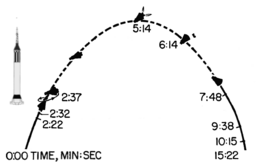
A Redstone rocket was used to boost the capsule for 2 minutes and 30 seconds to an altitude of 32 nautical miles (59 km); the capsule continued ascending on a ballistic curve after booster separation.[176][177] The launch escape system was jettisoned at the same time. At the top of the curve, the spacecraft's retrorockets were fired for testing purposes; they were not necessary for reentry because orbital speed had not been attained. The spacecraft landed in the Atlantic Ocean.[178] The suborbital mission took about 15 minutes, had an apogee altitude of 102–103 nautical miles (189–191 km), and a downrange distance of 262 nautical miles (485 km).[149][179] From the time of booster-spacecraft separation until reentry where air started to slow down the spacecraft, the pilot would experience weightlessness as shown on the image.[n 15] The recovery procedure would be the same as an orbital mission.[AS]
| Timetable (mm:ss) | |
|---|---|
| 0:00 | Launch |
| 2:22 | Launch vehicle cut-off and tower separation |
| 2:32 | Spacecraft separation |
| 2:37 | Turnaround |
| 5:14 | Retrofire |
| 6:14 | Retropack jettisoned |
| 7:48 | Reentry |
| 9:38 | Drogue deployed |
| 10:15 | Main chute deployed |
| 15:22 | Landing |
Orbital missions

Preparations for a mission started a month in advance with the selection of the primary and back-up astronaut; they would practice together for the mission.[180] For three days prior to launch, the astronaut went through a special diet to minimize his need for defecating during the flight.[181] On the morning of the trip he typically ate a steak breakfast.[181] After having sensors applied to his body and being dressed in the pressure suit, he started breathing pure oxygen to prepare him for the atmosphere of the spacecraft.[182] He arrived at the launch pad, took the elevator up the launch tower and entered the spacecraft two hours before launch.[183][n 16] Once the astronaut was secured inside, the hatch was bolted, the launch area evacuated and the mobile tower rolled back.[184] After this, the launch vehicle was filled with liquid oxygen.[184] The entire procedure of preparing for launch and launching the spacecraft followed a time table called the countdown. It started a day in advance with a pre-count, in which all systems of the launch vehicle and spacecraft were checked. After that followed a 15-hour hold, during which pyrotechnics were installed. Then came the main countdown which for orbital flights started 6½ hours before launch (T – 390 min), counted backwards to launch (T = 0) and then forward until orbital insertion (T + 5 min).[183][n 17]
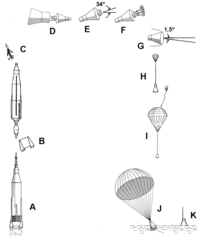
On an orbital mission, the Atlas' rocket engines were ignited four seconds before lift-off. The launch vehicle was held to the ground by clamps and then released when sufficient thrust was built up at lift-off (A).[186] After 30 seconds of flight, the point of maximum dynamic pressure against the vehicle was reached, at which the astronaut felt heavy vibrations.[187] After 2 minutes and 10 seconds, the two outboard booster engines shut down and were released with the aft skirt, leaving the center sustainer engine running (B).[183] At this point, the launch escape system was no longer needed, and was separated from the spacecraft by its jettison rocket (C).[56][n 18] The space vehicle moved gradually to a horizontal attitude until, at an altitude of 87 nautical miles (161 km), the sustainer engine shut down and the spacecraft was inserted into orbit (D).[189] This happened after 5 minutes and 10 seconds in a direction pointing east, whereby the spacecraft would gain speed from the rotation of the Earth.[190][n 19] Here the spacecraft fired the three posigrade rockets for a second to separate it from the launch vehicle.[192][n 20] Just before orbital insertion and sustainer engine cutoff, g-loads peaked at 8 g (6 g for a suborbital flight).[187][194] In orbit, the spacecraft automatically turned 180°, pointed the retropackage forward and its nose 14.5° downward and kept this attitude for the rest of the orbital phase to facilitate communication with the ground.[195][196][n 21]
Once in orbit, it was not possible for the spacecraft to change its
After reentry, a small, drogue parachute (H) was deployed at 21,000 ft (6,400 m) for stabilizing the spacecraft's descent.
-
Mercury crewed launches
-
John Glenn in orbit, 1962 (Mercury-Atlas 6)
-
Alan Shepard's 1961 recovery seen from helicopter (Mercury-Redstone 3)
Ground control

The number of personnel supporting a Mercury mission was typically around 18,000, with about 15,000 people associated with recovery.[2][206][n 25] Most of the others followed the spacecraft from the World Wide Tracking Network, a chain of 18 stations placed around the equator, which was based on a network used for satellites and made ready in 1960.[209] It collected data from the spacecraft and provided two-way communication between the astronaut and the ground.[210] Each station had a range of 700 nautical miles (1,300 km) and a pass typically lasted 7 minutes.[211] Mercury astronauts on the ground would take the role of Capsule Communicator, or CAPCOM, who communicated with the astronaut in orbit.[212][213][n 26] Data from the spacecraft were sent to the ground, processed at the Goddard Space Center by a redundant pair of transistorized IBM 7090 computers[214] and relayed to the Mercury Control Center at Cape Canaveral.[215] In the Control Center, the data were displayed on boards on each side of a world map, which showed the position of the spacecraft, its ground track and the place it could land in an emergency within the next 30 minutes.[196]
Other computers associated with ground control for Mercury included a vacuum-tube-based IBM 709 system in Cape Canaveral which determined whether a mid-launch abort might be needed and where an aborting capsule would land, another IBM 709 in Bermuda which served as backup for the two IBM 7090 transistor-based machines at Goddard, and a Burroughs-GE system which provided radio guidance for the Atlas during launch.[214]
The World Wide Tracking Network went on to serve subsequent space programs, until it was replaced by a satellite relay system in the 1980s.[216] Mission Control Center was moved from Cape Canaveral to Houston in 1965.[217]
-
Ground track and tracking stations for Mercury-Atlas 8. Spacecraft starts from Cape Canaveral in Florida and moves east; each new orbit-track is displaced to the left due to the rotation of the Earth. It moves between latitudes 32.5° north and 32.5° south.[218] Key: 1–6: orbit number. Yellow: launch. Black dot: tracking station. Red: range of station; Blue: landing.
Flights

On April 12, 1961, the Soviet
Crewed
All of the six crewed Mercury flights were successful, though some planned flights were canceled during the project (see below).
| Mission | Spacecraft No. | Call-sign | Pilot | Launch | Duration | Orbits | Apogee mi (km) |
Perigee mi (km) |
Max. velocity mph (km/h) |
Miss mi (km) | |
|---|---|---|---|---|---|---|---|---|---|---|---|
| time | site | ||||||||||
| MR-3 | 7 | Freedom 7 | Shepard | 14:34 on May 5, 1961 | LC-5
|
15 m 22 s | 0 | 117 (188) | — | 5,134 (8,262) | 3.5 (5.6) |
| MR-4 | 11 | Liberty Bell 7 | Grissom
|
12:20 on Jul. 21, 1961 | LC-5 | 15 m 37 s | 0 | 118 (190) | — | 5,168 (8,317) | 5.8 (9.3) |
| MA-6 | 13 | Friendship 7 | Glenn | 14:47 on Feb. 20, 1962 | LC-14
|
4 h 55 m 23 s | 3 | 162 (261) | 100 (161) | 17,544 (28,234) | 46 (74) |
| MA-7 | 18 | Aurora 7 | Carpenter | 12:45 on May 24, 1962 | LC-14 | 4 h 56 m 5 s | 3 | 167 (269) | 100 (161) | 17,549 (28,242) | 248 (400) |
| MA-8 | 16 | Sigma 7 | Schirra
|
12:15 on Oct. 3, 1962 | LC-14 | 9 h 13 m 15 s | 6 | 176 (283) | 100 (161) | 17,558 (28,257) | 4.6 (7.4) |
| MA-9 | 20 | Faith 7 | Cooper | 13:04 on May 15, 1963 | LC-14 | 1 d 10 h 19 m 49 s | 22 | 166 (267) | 100 (161) | 17,547 (28,239) | 5.0 (8.1) |
| Remarks | |
|---|---|
| Mercury-Redstone 3 | First American in space.[138] Recovered by carrier USS Lake Champlain.[21] |
| Mercury-Redstone 4 | Spacecraft sank during recovery when hatch unexpectedly blew off.[226][n 28] Astronaut recovered by carrier USS Randolph.[227] |
| Mercury-Atlas 6 | First American in orbit.[228] Retropack retained during reentry.[229][n 29] Recovered by destroyer USS Noa.[231] |
| Mercury-Atlas 7 | Carpenter replaced Deke Slayton.[232][n 30] Recovered by destroyer USS Farragut.[234] Biggest miss.[n 31] |
| Mercury-Atlas 8 | The flight closest to plan.[236] Carried out maneuvering tests.[237] Recovered by carrier USS Kearsarge.[238] |
| Mercury-Atlas 9 | First American in space for over a day.[239] Last American solo mission.[n 32] Recovered by USS Kearsarge.[90] |
| Recovery variations | MA6) spacecraft and astronaut hoist onboard directly; MA8) spacecraft and astronaut towed by boat to ship; MA9) spacecraft with astronaut inside flown to ship.[241] |
-
Shepard's flight watched on TV in the White House. May 1961.
-
John Glenn honored by the President. February 1962
-
USS Kearsarge with crew spelling Mercury-9. May 1963.
Uncrewed and chimpanzee flights
The 20 uncrewed flights used Little Joe, Redstone, and Atlas launch vehicles.[137] They were used to develop the launch vehicles, launch escape system, spacecraft and tracking network.[224] One flight of a Scout rocket attempted to launch a specialized satellite equipped with Mercury communications components for testing the ground tracking network, but the booster failed soon after liftoff. The Little Joe program used seven airframes for eight flights, of which three were successful. The second Little Joe flight was named Little Joe 6, because it was inserted into the program after the first 5 airframes had been allocated.[242][181] Production spacecraft and boilerplates were used for these test flights.[225]
| Mission[n 33] | Spacecraft No. | Launch | Duration | Purpose | Result |
|---|---|---|---|---|---|
| Little Joe 1 | Boilerplate | August 21, 1959 | 20 s | Test of launch escape system during flight. | Failure |
| Big Joe 1 | Big Joe Boilerplate | September 9, 1959 | 13 m 00 s | Test of heat shield and Atlas/spacecraft interface. | Partial success |
| Little Joe 6 | Boilerplate | October 4, 1959 | 5 m 10 s | Test of spacecraft aerodynamics and integrity. | Partial success |
| Little Joe 1A | Boilerplate | November 4, 1959 | 8 m 11 s | Test of launch escape system during flight with boiler plate capsule. | Partial success |
| Little Joe 2 | Boilerplate | December 4, 1959 | 11 m 6 s | Escape system test with primate at high altitude. | Success |
| Little Joe 1B | Boilerplate | January 21, 1960 | 8 m 35 s | Maximum-q abort and escape test with primate with boiler plate capsule. | Success |
| Beach Abort | 1 | May 9, 1960 | 1 m 31 s | Test of the off-the-pad abort system. | Success |
| Mercury-Atlas 1 | 4 | July 29, 1960 | 3 m 18 s | Test of spacecraft / Atlas combination. | Failure |
| Little Joe 5 | 3 | November 8, 1960 | 2 m 22 s | First Little Joe escape system test with a production spacecraft, at max-q. | Failure |
| Mercury-Redstone 1 | 2 | November 21, 1960 | 2 s | Qualification of spacecraft / Redstone combination. | Failure |
| Mercury-Redstone 1A | 2 | December 19, 1960 | 15 m 45 s | Qualification of spacecraft / Redstone combination. | Success |
| Mercury-Redstone 2 | 5 | January 31, 1961 | 16 m 39 s | Qualification of spacecraft with chimpanzee named Ham. | Success |
| Mercury-Atlas 2 | 6 | February 21, 1961 | 17 m 56 s | Qualified Mercury/Atlas interface. | Success |
| Little Joe 5A | 14 | March 18, 1961 | 5 m 25 s | Second test of escape system with a production Mercury spacecraft. | Partial success |
| Mercury-Redstone BD | Boilerplate | March 24, 1961 | 8 m 23 s | Final Redstone test flight. | Success |
| Mercury-Atlas 3 | 8 | April 25, 1961 | 7 m 19 s | Orbital flight with robot astronaut.[243][244][n 34] | Failure |
| Little Joe 5B | 14 | April 28, 1961 | 5 m 25 s | Third test of escape system with a production spacecraft. | Success |
| Mercury-Atlas 4 | 8 | September 13, 1961 | 1 h 49 m 20 s | Test of environmental control system with robot astronaut in orbit. | Success |
| Mercury-Scout 1 | - | November 1, 1961 | 44 s | Special satellite to test Mercury tracking network. | Failure |
| Mercury-Atlas 5 | 9 | November 29, 1961 | 3 h 20 m 59 s | Test of environmental control system in orbit with chimpanzee named Enos. | Success |
| Remarks | |
|---|---|
| Little Joe 1 | Due to an electrical malfunction, the escape tower ignited ½ hour before launch and took the spacecraft with it, leaving the rocket on the ground.[246] |
| Big Joe 1 | Actually the first Mercury-Atlas flight.[137] Recovered by USS Strong 2,407 km SE of Cape Canaveral.[247] Altitude: 65 mi (105 km) Qualified ablative heatshield.[104] |
| Little Joe 6 | No additional tests[248] |
| Little Joe 1A | The rescue tower rocket ignited 10 seconds too late.[249] Recovered by USS Opportune 11.5 mi (18.5 km) SE of Wallops Island.[250] |
| Little Joe 2 | Carried Sam, a rhesus macaque.[249] Recovered by USS Borie 194 mi (312 km) SE of Wallops Island, Virginia; altitude: 53 mi (85 km).[251] |
| Little Joe 1B | Carried a female rhesus monkey named Miss Sam.[252] |
| Beach Abort | A production spacecraft with minimal equipment was lifted from the ground by the launch escape system alone at Wallops Island. It reached an apogee of 0.751 kilometres (2,465 ft) and was recovered after landing. Top velocity: 436 metres per second (976 mph). Total payload: 1,154 kg. |
| Mercury-Atlas 1 | Exploded while passing through max-q.[253] To save weight, the airframe had been made thinner since Big Joe, which led to a collapse. The next Atlas was strengthened by a temporary solution while the rest were made from the same specifications as Big Joe.[254] |
| Little Joe 5 | The clamp holding the spacecraft was deflected by air pressure; due to this and incorrect wiring, the escape tower ignited too early and further failed to separate spacecraft from launch vehicle.[43][n 35] Altitude: 10 mi (16 km)[255] |
| Mercury-Redstone 1 | Engine shutdown caused by improper separation of electrical cables;[256] vehicle rose 4 in (10 cm) and settled back on the pad.[257][n 36] |
| Mercury-Redstone 1A | First flight of Mercury / Redstone. Recovered by USS Valley Forge.[258] Altitude: 130 mi (210 km)[109] |
| Mercury-Redstone 2 | Carried the chimpanzee Ham on suborbital flight. Recovered by USS Donner[259] 422 mi (679 km) SE of Cape Canaveral; altitude: 157 mi (253 km)[260] |
| Mercury-Atlas 2 | Recovered by USS Donner[261] 1,432 mi (2,305 km) SE of Cape Canaveral. |
| Little Joe 5A | Tower fired 14 seconds too soon; it failed to separate the spacecraft from the rocket.[262] |
| Mercury-Redstone BD | BD: Booster Development)[263] |
| Mercury-Atlas 3 | Upgraded from suborbital flight. Was aborted when the Atlas continued to vertically climb instead of tilting toward orbit; escaping capsule was recovered and reused in Mercury-Atlas 4.[264] |
| Little Joe 5B | Concluded Little Joe program. |
| Mercury-Atlas 4 | Completed one orbit and sent data to the ground; first orbital flight of the project.[265] Recovery by USS Decatur 176 mi (283 km) east of Bermuda.[266] |
| Mercury-Scout 1 | Was aborted after malfunction of booster's guidance system;[267] results of Mercury-Atlas 4 and Mercury-Atlas 5 were used instead.[268] |
| Mercury-Atlas 5 | Chimpanzee Enos completed a two-orbit flight, performing tasks to prove it possible for a person to function during a flight.[269][n 37] Last Mercury-Atlas test flight. Recovery by USS Stormes[271] 255 mi (410 km) SE of Bermuda.[272] |
-
Little Joe 1B at launch with Miss Sam, 1960
-
Mercury-Redstone 1: launch escape system lift-off after 4'' launch, 1960
-
Mercury-Redstone 2: Ham, 1961
-
Mercury-Atlas 5: Enos, 1961
Canceled
Nine of the planned flights were canceled. Suborbital flights were planned for four other astronauts but the number of flights was cut down gradually and finally all remaining were canceled after Titov's flight.[273][274][n 38] Mercury-Atlas 9 was intended to be followed by more one-day flights and even a three-day flight but with the coming of the Gemini Project it seemed unnecessary. The Jupiter booster was, as mentioned above, intended to be used for different purposes.
| Mission | Pilot | Planned Launch | Cancellation |
|---|---|---|---|
| Mercury-Jupiter 1 | July 1, 1959[276] | ||
| Mercury-Jupiter 2 | Chimpanzee | First quarter, 1960 | July 1, 1959[276][n 39] |
| Mercury-Redstone 5 | Glenn (likely) | March 1960[274] | August 1961[278] |
| Mercury-Redstone 6 | April 1960[274] | July 1961[279] | |
| Mercury-Redstone 7 | May 1960[274] | ||
| Mercury-Redstone 8 | June 1960[274] | ||
| Mercury-Atlas 10 | Shepard | October 1963 | June 13, 1963[n 40] |
| Mercury-Atlas 11 | Grissom | Fourth quarter, 1963 | October 1962[281] |
| Mercury-Atlas 12 | Schirra | Fourth quarter, 1963 | October 1962[282] |
Legacy
Today the Mercury program is commemorated as the first American human space program.[283] It did not win the race against the Soviet Union, but gave back national prestige and was scientifically a successful precursor of later programs such as Gemini, Apollo and Skylab.[284][n 41]
During the 1950s, some experts doubted that human spaceflight was possible.[n 42] Still, when John F. Kennedy was elected president, many, including him, had doubts about the project.[287] As president he chose to support the programs a few months before the launch of Freedom 7,[288] which became a public success.[289][n 43] Afterwards, a majority of the American public supported human spaceflight, and, within a few weeks, Kennedy announced a plan for a crewed mission to land on the Moon and return safely to Earth before the end of the 1960s.[293]
The six astronauts who flew were awarded medals,[294] driven in parades and two of them were invited to address a joint session of the US Congress.[295] Seeing as no women previously met the qualifications for the astronaut program, the question was raised as to whether or not they could. This led to the development of a project named Mercury 13 by the media, in which thirteen American women successfully underwent the tests. The Mercury 13 program was not officially conducted by NASA. It was created by NASA physician William Randolph Lovelace, who developed the physical and psychological tests used to select NASA's first seven male astronauts for Project Mercury. The women completed physical and psychological tests, but were never required to complete the training as the privately funded program was quickly cancelled. No female candidates adequately met the qualifications for the astronaut program until 1978, when a few finally qualified for the Space Shuttle program.[296]
On February 25, 2011, the Institute of Electrical and Electronics Engineers, the world's largest technical professional society, awarded Boeing (the successor company to McDonnell Aircraft) a Milestone Award for important inventions which debuted on the Mercury spacecraft.[297][n 44]
Depictions on film
A short documentary, The John Glenn Story, was released in 1962.
On film the program was portrayed in The Right Stuff, a 1983 adaptation of Tom Wolfe's 1979 book of the same name,[298] in the 1998 HBO miniseries From the Earth to the Moon, in the 2016 film Hidden Figures and the 2020 Disney+ series The Right Stuff which is also based on the Tom Wolfe book.
Commemorations
In 1964, a monument commemorating Project Mercury was unveiled near Launch Complex 14 at Cape Canaveral, featuring a metal logo combining the symbol of Mercury with the number 7.[299] In 1962, the United States Postal Service honored the Mercury-Atlas 6 flight with a Project Mercury commemorative stamp, the first US postal issue to depict a crewed spacecraft.[300][n 45]
-
Mercury monument at Launch Complex 14, 1964
-
Commemorative Project Mercury 4¢ US Postage stamp[n 46]
Displays
The spacecraft that flew, together with some that did not, are on display in the United States. Friendship 7 (Spacecraft No. 13) went on a global tour, popularly known as its "fourth orbit".[302]
-
Little Joe 5B (Spacecraft No 14), Virginia Air and Space Center
-
Big Joe Boilerplate, Steven F. Udvar-Hazy Center
-
Kennedy Space Center
-
Mercury-Redstone 2 (Spacecraft No. 5), California Science Center
-
Freedom 7 (Spacecraft No. 7) at the United States Naval Academy, 2010
-
Kansas Cosmosphere and Space Center, 2010
-
Friendship 7 (Spacecraft No. 13) at the National Air and Space Museum, 2009
-
Museum of Science and Industry, 2009
-
Sigma 7 (Spacecraft No. 16) at the United States Astronaut Hall of Fame, 2011
-
Faith 7 (Spacecraft No. 20) at Space Center Houston, 2011
-
Unflown Freedom 7 II (Spacecraft No. 15B) at Steven F. Udvar-Hazy Center
-
Unflown (Spacecraft No. 10), Evergreen Aviation & Space Museum
-
Mercury Procedures Trainer at the U.S. Space and Rocket Center, 2011
Patches
Commemorative patches were designed by
Videos
-
John Glenn documentary from 50th Anniversary of Friendship 7, 2012.
Space program comparison
See also
Notes
- ^ Designed in 1964 from Mercury Seven astronaut memorial
- ^ The project was delayed by 22 months, counting from the beginning until the first orbital mission.[2] It had a dozen prime contractors, 75 major subcontractors, and about 7200 third-tier subcontractors.[2] The cost estimate made by NASA in 1969 was $392.6 million, broken down as follows: Spacecraft: $135.3 million, launch vehicles: $82.9 million, operations: $49.3 million, tracking operations and equipment: $71.9 million and facilities: $53.2 million.[3][4]
- ^ Man in Space Soonest was the first part of a four-phase Moon landing program estimated to finish in 1965, cost a total of $1.5 billion ($15.7 billion adjusted for inflation), and be launched by a "Super Titan" rocket.[9]
- ^ The name Little Joe was adopted by its designers from the throw of a double deuce in a craps game since this resembled the four-rocket arrangement in the blueprints for the vehicle.[34]
- ^ NASA's planning for recovery operations in the summer of 1960 was, according to the Navy, asking for the deployment of the whole Atlantic Fleet and might have cost more than the entire Mercury program.[45]
- ^ The decision to eliminate the use of any gas but oxygen was crystalized when a serious accident occurred on April 21, 1960, in which McDonnell Aircraft test pilot G.B. North passed out and was seriously injured when testing a Mercury cabin/spacesuit atmosphere system in a vacuum chamber. The problem was found to be nitrogen-rich (oxygen-poor) air leaking from the cabin into his spacesuit feed.[77]
- ^ Pilot and spacecraft data sent automatically to the ground is called telemetry.[81]
- ^ Moisture and urine was recycled into drinking water.[49]
- ^ The rocket plane approach to human space flight was pursued by the Air Force with their Dyna-Soar project, which was canceled in 1963.[101] Toward the end of the 1960s, NASA began the development of a reusable space plane, which was ultimately developed into the Space Shuttle program.[102] The first rocket plane to enter space was an X-15 in 1963.[103]
- ^ Test and rework of Mercury-Redstone 2 at the Hangar required 110 days.[109] Hangar S was also the place where the chimpanzees were trained.[110]
- ^ They received a letter designation after their number, e.g., 2B, 15B.[113] Some were modified twice: for example, spacecraft 15 became 15A and then 15B.[114]
- ^ At the time, the word "booster" was sometimes used for the first stage of the launch stack. Later, "booster" came to refer to additional single-stage rockets attached to the sides of the main launch vehicle, as on the Space Shuttle.
- ^ Armstrong left the Navy as a Lieutenant, Junior Grade in the US Naval Reserve, until resigning his commission 1960.[158]
- ^ At the beginning of the project both President Eisenhower and NASA's first administrator, T. K. Glennan, believed that the US would put the first man in space, and that this would be the end of the Space Race.[164]
- ^ With the exception of the 20 seconds of retrofire during which the pilot would experience g-force.
- ^ Inside the spacecraft the other astronauts had usually prepared a practical joke, such as a sign saying "No handball playing".[184]
- ^ Countdown was controlled from the blockhouse at the Launch Complex until 2 min. before launch then it was transferred to Mission Control Center. The countdown of the last 10 sec. before launch would be given to the astronaut by one of the others and included on TV transmissions which had already started.[185]
- ^ In the event of a launch abort before this point, the launch escape system would fire its main rocket for one second, pulling the spacecraft and astronaut away from the launch vehicle and a possible explosion.[70] At this point, the spacecraft could be separated from the launch vehicle and land using its parachute.[188]
- ^ The direction of insertion was east and slightly to the north, meaning that, on a three-orbit flight, the tracking network was used optimally and a landing could take place in the North Atlantic Ocean.[191]
- ^ The sustainer would disintegrate and fall down; after the launch of Friendship 7 a part of the sustainer was found in South Africa.[193]
- ^ The capsule's tendency to drift was countered automatically by the attitude control system (ASCS) which used small hydrogen peroxide thrusters. To save fuel, however, the spacecraft would be allowed to drift from time to time, especially on longer missions.[197]
- SOFAR bomb which could be detected by the recovery ship's hydrophone were eliminated as unnecessary measures after the first orbital flight.[204]
- ^ The collar was not ready for suborbital missions.[205]
- ^ It was also possible to exit the capsule through the nose cylinder; only Carpenter did this.[30][67]
- ^ T. J. O'Malley pushed the button to launch Glenn[207] while the Site Manager and Launch Conductor at Complex 14, Calvin D. Fowler, pushed the button to launch Carpenter, Schirra, and Cooper.[208]
- ^ Occasionally this communication was broadcast on live TV while the spacecraft was passing over the United States.
- ^ Alexander & al., 1966, pp. 638–641.
- ^ It was recovered in 1999.[112]
- ^ Launch of Friendship 7 was postponed repeatedly during two months; a frustrated politician compared the spacecraft-Atlas combination to "a Rube Goldberg device on top of a plumber's nightmare".[230]
- ^ Carpenter's overshoot of the landing site was caused by a malfunction in the automatic stabilization, which meant that retrofire was out of line with the movement of the spacecraft[233]
- ^ During Carpenter's mission a seaplane from the US Air Force got to the landing site about 1½ hour ahead of the Navy ships and offered to pick him up. This, however, was declined by the admiral in charge of Mercury recovery operations, which led to a Senate hearing about the incident.[235]
- ^ Likely to be so according to Alexander & al.[240]
- ^ Source: Alexander & al., 1966, pp. 638–641 when nothing else is mentioned.
- ^ A machine that produced the same heat, vapor and CO2 as an astronaut.[245]
- ^ The clamp was subsequently tested by a rocket sled.[43]
- ^ Immediately after the Redstone's engine shut down, the capsule's escape rocket jettisoned itself, leaving the capsule attached to the booster. The escape rocket rose to an altitude of 4,000 ft (1,200 m) and landed about 400 yd (370 m) away. Three seconds after the escape rocket fired, the capsule deployed its drogue parachute; it then deployed the main and reserve parachutes.[257]
- ^ Was given a reward in the form a banana pellet or a punishment in the form of mild electrical shocks depending on whether or not he gave the right response to a given signal; by mistake he was sometimes given shocks on right answers.[270]
- ^ Within the Mercury Project organization the suborbital flights were from the start criticized as being of little value and even compared to a circus act.[275]
- ^ Proposed maximum dynamic pressure test for capsule.[277]
- ^ Mercury-Atlas 10 was intended to be a three-day mission in November 1962 with extra supplies attached to the heat shield. Call-sign Freedom 7-II. By January 1963, it was changed to a one-day back up mission for Mercury-Atlas 9. It was canceled after the success of the latter.[280]
- ^ International rules required that a pilot must land safely with the spacecraft; in reality, Gagarin landed separately by parachute; however, the Soviet Union did not admit this until 1971 when their claim was no longer in danger of being challenged.[285]
- ^ In May 1957, five months before Sputnik I, the president of McDonnell, later the prime contractor, predicted that human spaceflight would not take place before 1990.[286]
- communication satellite to television audiences in Western Europe.[291] Two of the three major US networks covered Sigma 7 minute-by-minute, while the third was showing the opening of the World Series.[292]
- ^ Boeing received the award in recognition of Project Mercury's pioneering "navigation and control instruments, autopilot, rate stabilization and control, and fly-by-wire systems."[297]
- ^ The stamp first went on sale in Cape Canaveral, Florida on February 20, 1962, the same day as the first crewed orbital flight.[300] On May 4, 2011, the Postal Service released a stamp commemorating the 50th anniversary of Freedom 7, the first flight of the project with people onboard.[301]
- ^ The stamp was issued February 20, 1962, the day of John Glenn's flight in Friendship 7. This one has a First day of issue postmark from Cape Canaveral post office.
- ^ The only patches the Mercury astronauts wore were the NASA logo and a name tag.[303] Each crewed Mercury spacecraft was painted black and decorated with a flight insignia, its call-sign, an American flag and the words United States.[56]
References
- ^ a b Lafleur, Claude (March 8, 2010). "Costs of US piloted programs". The Space Review. Retrieved February 18, 2012.
- ^ a b c d Alexander & al. 1966, p. 508.
- ^ Wilford 1969, p. 67.
- ^ Alexander & al. 1966, p. 643.
- ^ Grimwood 1963, p. 12.
- ^ a b Alexander & al. 1966, p. 132.
- ^ a b c Catchpole 2001, p. 92.
- ^ Alexander & al. 1966, p. 102.
- ^ Alexander & al. 1966, p. 91.
- ^ Catchpole 2001, pp. 12–14.
- ^ a b Catchpole 2001, p. 81.
- ^ Alexander & al. 1966, pp. 28, 52.
- ^ Catchpole 2001, p. 55.
- ^ Alexander & al. 1966, p. 113.
- ^ Catchpole 2001, pp. 57, 82.
- ^ Catchpole 2001, p. 70.
- ^ Alexander & al. 1966, p. 13.
- ^ Alexander & al. 1966, p. 44.
- ^ Alexander & al. 1966, p. 59.
- ^ Catchpole 2001, p. 466.
- ^ a b Alexander & al. 1966, p. 357.
- ^ Alexander & al. 1966, pp. 35, 39–40.
- ^ Alexander & al. 1966, p. 49.
- ^ Alexander & al. 1966, pp. 37–38.
- ^ a b Alexander & al. 1966, p. 61.
- ^ Alexander & al. 1966, pp. 98–99.
- ^ Catchpole 2001, p. 82.
- ^ Alexander & al. 1966, pp. xiii, 134.
- ^ a b Alexander & al. 1966, p. 134.
- ^ a b Alexander & al. 1966, p. 143.
- ^ Catchpole 2001, p. 157.
- ^ Alexander & al. 1966, pp. 121, 191.
- ^ a b c Alexander & al. 1966, p. 137.
- ^ a b Alexander & al. 1966, p. 124.
- ^ Alexander & al. 1966, p. 216.
- ^ a b c Alexander & al. 1966, p. 21.
- ^ Catchpole 2001, p. 158.
- ^ Catchpole 2001, p. 89–90.
- ^ Catchpole 2001, p. 86.
- ^ Alexander & al. 1966, p. 141.
- ^ a b Catchpole 2001, pp. 103–110.
- ^ a b Alexander & al. 1966, p. 88.
- ^ a b c Catchpole 2001, p. 248.
- ^ a b Catchpole 2001, pp. 172–173.
- ^ Alexander & al. 1966, p. 265.
- ^ a b "History-At-A-Glance". City of Cocoa Beach. Archived from the original on January 4, 2013. Retrieved June 24, 2013.
- ^ Catchpole 2001, p. 150.
- ^ a b Catchpole 2001, p. 131.
- ^ a b Alexander & al. 1966, p. 47.
- ^ Alexander & al. 1966, p. 245.
- ^ Alexander & al. 1966, p. 490.
- ^ Catchpole 2001, p. 136.
- ^ Catchpole 2001, pp. 134–136.
- ^ Alexander & al. 1966, pp. 140, 143.
- ^ Catchpole 2001, pp. 132–134.
- ^ a b c d Catchpole 2001, p. 132.
- ^ Alexander & al. 1966, p. 188.
- ^ a b Catchpole 2001, p. 134.
- ^ Catchpole 2001, pp. 136–144.
- ^ Catchpole 2001, pp. 136–137.
- ^ a b Catchpole 2001, p. 138.
- ^ a b c d Catchpole 2001, p. 139.
- ^ a b Catchpole 2001, pp. 144–145.
- ^ a b c d Catchpole 2001, p. 144.
- ^ Catchpole 2001, p. 135.
- ^ Catchpole 2001, pp. 145–148.
- ^ a b c Catchpole 2001, p. 147.
- ^ Alexander & al. 1966, p. 199.
- ^ Catchpole 2001, pp. 179–181.
- ^ a b Catchpole 2001, p. 179.
- ^ a b NASA (March 1988). "Computers in Spaceflight: The NASA Experience – Chapter One: The Gemini Digital Computer: First Machine in Orbit". NASA History. NASA. Retrieved September 15, 2016.
- ^ Rutter, Daniel (October 28, 2004). "Computers in space". Dan's Data. Retrieved September 15, 2016.
- ^ Catchpole 2001, p. 142.
- ^ a b Catchpole 2001, p. 191.
- ^ Gatland 1976, p. 264.
- ^ Catchpole 2001, p. 410.
- ^ a b Giblin 1998.
- ^ Alexander & al. 1966, pp. 48–49.
- ^ Alexander & al. 1966, p. 246.
- ^ Catchpole 2001, pp. 191, 194.
- ^ Alexander & al. 1966, p. 313.
- ^ Catchpole 2001, pp. 343–344.
- ^ Hollins 2013.
- ^ "The History of Urinating in Space". ABC. Retrieved December 27, 2023.
- ^ Alexander & al. 1966, p. 98.
- ^ Alexander & al. 1966, p. 499.
- ^ Catchpole 2001, p. 143.
- ^ Catchpole 2001, p. 141.
- ^ Catchpole 2001, pp. 98–99.
- ^ a b Alexander & al. 1966, p. 501.
- ^ Unknown 1962, p. 8.
- ^ Catchpole 2001, p. 152.
- ^ Catchpole 2001, p. 153.
- ^ Catchpole 2001, p. 159.
- ^ Catchpole 2001, p. 149.
- ^ Alexander & al. 1966, p. 63.
- ^ Alexander & al. 1966, p. 64.
- ^ Alexander & al. 1966, p. 206.
- ^ Alexander & al. 1966, pp. 78–80.
- ^ Alexander & al. 1966, p. 72.
- ^ Catchpole 2001, pp. 425, 428.
- ^ "Introduction to future launch vehicle plans [1963–2001]. 3.The Space Shuttle (1968–72)". Retrieved February 3, 2014.
- ^ Garber, Steve. "X – 15 Hypersonic Research at the Edge of Space". NASA History Homepage. NASA. Retrieved July 18, 2015.
- ^ a b Catchpole 2001, p. 229.
- ^ a b Catchpole 2001, p. 196.
- ^ Alexander & al. 1966, p. 198.
- ^ Catchpole 2001, pp. 132, 159.
- ^ Catchpole 2001, pp. 184–188.
- ^ a b Alexander & al. 1966, p. 310.
- ^ Alexander & al. 1966, p. 312.
- ^ a b c Grimwood 1963, pp. 235–238.
- ^ a b Catchpole 2001, pp. 402–405.
- ^ Grimwood 1963, pp. 216–218.
- ^ Grimwood 1963, p. 149.
- ^ Alexander & al. 1966, pp. 126 & 138.
- ^ Alexander & al. 1966, pp. 96, 105.
- ^ Catchpole 2001, p. 107.
- ^ McDonnell Douglas Logo History, McDonnell Douglas, archived from the original on June 5, 1997, retrieved November 29, 2020
- ^ a b Catchpole 2001, p. 197.
- ^ Alexander & al. 1966, p. 638.
- ^ Catchpole 2001, p. 223.
- ^ Catchpole 2001, p. 284.
- ^ Catchpole 2001, p. 198.
- ^ Alexander & al. 1966, p. 125.
- ^ Alexander & al. 1966, pp. 392–397.
- ^ a b Catchpole 2001, p. 206.
- ^ Catchpole 2001, p. 207.
- ^ Catchpole 2001, pp. 209, 214.
- ^ Alexander & al. 1966, p. 151.
- ^ Grimwood 1963, p. 69.
- ^ a b c d Catchpole 2001, p. 211.
- ^ Alexander & al. 1966, p. 22.
- ^ Catchpole 2001, p. 212.
- ^ Catchpole 2001, pp. 225, 250.
- ^ Catchpole 2001, pp. 458–459.
- ^ Alexander & al. 1966, p. 164.
- ^ a b c d Alexander & al. 1966, p. 640.
- ^ a b c Alexander & al. 1966, p. 341.
- ^ Catchpole 2001, p. 445.
- ^ Dunbar, B. (2015, May 12). Who was Alan shepherd? Retrieved April 22, 2021, from https://www.nasa.gov/audience/forstudents/k-4/stories/nasa-knows/who-was-alan-shepard-k4.html
- ^ Catchpole 2001, p. 442.
- ^ Documents – human Space Flight: A record of ACHIEVEMENT, 1961 – 1998. (n.d.). Retrieved April 22, 2021, from https://history.nasa.gov/SP-4225/documentation/hsf-record/hsf.htm#mercury
- ^ Catchpole 2001, pp. 440, 441.
- ^ Dunbar, B. (2016, December 05). Profile of John Glenn. Retrieved April 22, 2021, from https://www.nasa.gov/content/profile-of-john-glenn
- ^ Fox, S. (2015, February 20). Scott carpenter, 1925–2013. Retrieved April 22, 2021, from https://www.nasa.gov/astronautprofiles/carpenter Archived November 4, 2021, at the Wayback Machine
- ^ Catchpole 2001, pp. 446–447.
- ^ 40Th anniversary of Mercury 7: WALTER Marty Schirra, jr. (n.d.). Retrieved April 22, 2021, from https://history.nasa.gov/40thmerc7/schirra.htm
- ^ Administrator, N. (2015, February 27). Remembering Gordon Cooper. Retrieved April 22, 2021, from https://www.nasa.gov/multimedia/imagegallery/image_feature_218.html
- ^ a b c d Alexander & al. 1966, pp. 640–641.
- ^ Catchpole 2001, p. 99.
- ^ Catchpole 2001, p. 96.
- ^ a b Catchpole 2001, p. 100.
- ^ Catchpole 2001, p. 97.
- ^ Australian Broadcasting Corporation (February 15, 2008). "Moment in Time – Episode 1". Australian Broadcasting Corporation. Retrieved June 25, 2013.
- ^ a b Dunbar, Brian (March 17, 2015). "Project Mercury Overview – Astronaut Selection". nasa.gov. NASA. Retrieved April 24, 2018.
- ^ Alexander & al. 1966, pp. 160–161.
- ^ Hansen 2005, p. 173.
- ^ Hansen 2005, p. 118.
- ^ Hansen 2005, pp. 201–202.
- ^ Nelson 2009, p. 17.
- ^ a b c d Catchpole 2001, pp. 92–93.
- ^ Cloer, Dan. "Alan B. Shepard, Jr.: Spam in a Can?". vision.org. Vision. Retrieved April 24, 2018.
- ^ Catchpole 2001, p. 440.
- ^ Catchpole 2001, p. 407.
- ^ Catchpole 2001, p. 93.
- ^ a b c Catchpole 2001, p. 98.
- ^ Minard, D. (1964). Work Physiology. Archives of Environmental Health. 8(3): 427–436.
- ^ Catchpole 2001, p. 94.
- ^ Catchpole 2001, p. 104.
- ^ Catchpole 2001, p. 105.
- ^ "Gimbal Rig Mercury Astronaut Trainer". NASA. June 9, 2008. Retrieved December 13, 2014.
- YouTube
- ^ Catchpole 2001, pp. 105, 109.
- ^ Catchpole 2001, p. 111.
- ^ Alexander & al. 1966, p. 346.
- ^ Unknown 1961a, p. 7.
- ^ Catchpole 2001, pp. 208, 250.
- ^ Catchpole 2001, pp. 250, 308.
- ^ a b Catchpole 2001, p. 475.
- ^ Catchpole 2001, p. 110.
- ^ a b c Catchpole 2001, p. 278.
- ^ Catchpole 2001, p. 280.
- ^ a b c Catchpole 2001, p. 188.
- ^ a b c Catchpole 2001, p. 281.
- ^ Catchpole 2001, p. 282.
- ^ Catchpole 2001, pp. 188, 242.
- ^ a b Catchpole 2001, p. 340.
- ^ Catchpole 2001, p. 180.
- ^ Unknown 1962, p. 46.
- ^ Catchpole 2001, pp. 188, 460.
- ^ Alexander & al. 1966, p. 215.
- ^ a b Catchpole 2001, p. 133.
- ^ Grimwood 1963, p. 164.
- ^ Unknown 1961, p. 10.
- ^ a b Alexander & al. 1966, p. 333.
- ^ a b Catchpole 2001, p. 120.
- ^ Alexander & al. 1966, pp. 195, 450.
- ^ Catchpole 2001, p. 462.
- ^ Catchpole 2001, p. 324.
- ^ Unknown 1961, p. 9.
- ^ Alexander & al. 1966, p. 574.
- ^ Unknown 1962, p. 9.
- ^ a b Alexander & al. 1966, p. 356.
- ^ Alexander & al. 1966, p. 445.
- ^ a b Catchpole 2001, p. 166.
- ^ Unknown 1962, p. 3.
- ^ Hevesi, Dennis (November 12, 2009). "Thomas J. O'Malley, Who Helped Launch Glenn Into Orbit, Dies at 94". The New York Times.
- ^ "Letter from General Ben I. Funk to Dr. Calvin D. Fowler (May 14, 1963)". University of Central Florida. Retrieved February 1, 2023.
- ^ Catchpole 2001, pp. 124, 461–462.
- ^ Catchpole 2001, p. 117.
- ^ Catchpole 2001, pp. 121, 126.
- ^ Alexander & al. 1966, p. 360.
- ^ Alexander & al. 1966, p. 479.
- ^ a b NASA (March 1988). "Computers in Spaceflight: The NASA Experience – Chapter Eight: Computers in Mission Control". NASA History. NASA. Retrieved June 27, 2021.
- ^ Catchpole 2001, p. 118.
- ^ Catchpole 2001, p. 409.
- ^ Catchpole 2001, p. 88.
- ^ Catchpole 2001, p. 128.
- ^ Alexander & al. 1966, p. 332.
- ^ "Geek Trivia: A leap of fakes". September 14, 2004. Retrieved April 13, 2022.
- ^ "Gagarin's Falsified Flight Record". Seeker. Retrieved July 7, 2022.
- ^ Alexander & al. 1966, pp. 377, 422.
- ^ Catchpole 2001, p. 476.
- ^ a b Alexander & al. 1966, pp. 638–641.
- ^ a b "Project Mercury - A Chronology. Appendix 6". history.nasa.gov. Retrieved October 20, 2023.
- ^ Alexander & al. 1966, p. 373.
- ^ Alexander & al. 1966, p. 375.
- ^ Alexander & al. 1966, p. 422.
- ^ Alexander & al. 1966, p. 432.
- ^ Alexander & al. 1966, p. 409, 411.
- ^ Alexander & al. 1966, p. 433.
- ^ Alexander & al. 1966, p. 440.
- ^ Alexander & al. 1966, p. 453-454.
- ^ Alexander & al. 1966, p. 456.
- ^ Alexander & al. 1966, p. 457.
- ^ Alexander & al. 1966, p. 484.
- ^ Alexander & al. 1966, p. 476.
- ^ Alexander & al. 1966, p. 483.
- ^ Alexander & al. 1966, p. 487.
- ^ Alexander & al. 1966, p. 506.
- ^ Alexander & al. 1966, pp. 353, 375, 433, 457, 483–484, 501.
- ^ Catchpole 2001, p. 231.
- ^ Alexander & al. 1966, p. 335.
- ^ Catchpole 2001, p. 275.
- ^ Catchpole 2001, p. 309.
- ^ Alexander & al. 1966, p. 208.
- ^ Alexander & al. 1966, pp. 203–204.
- ^ Alexander & al. 1966, p. 209.
- ^ a b Alexander & al. 1966, p. 210.
- ^ Catchpole 2001, p. 232.
- ^ Catchpole 2001, pp. 234, 474.
- ^ Alexander & al. 1966, p. 212.
- ^ Alexander & al. 1966, p. 276.
- ^ Catchpole 2001, p. 243.
- ^ Alexander & al. 1966, p. 291.
- ^ Alexander & al. 1966, p. 298.
- ^ a b Alexander & al. 1966, p. 294.
- ^ Alexander & al. 1966, p. 297.
- ^ Alexander & al. 1966, p. 316.
- ^ Alexander & al. 1966, pp. 638–639.
- ^ Alexander & al. 1966, pp. 321–322.
- ^ Alexander & al. 1966, p. 327.
- ^ Alexander & al. 1966, p. 330.
- ^ Alexander & al. 1966, p. 337.
- ^ Alexander & al. 1966, p. 386-387.
- ^ Alexander & al. 1966, p. 389.
- ^ Alexander & al. 1966, p. 397.
- ^ Catchpole 2001, p. 312.
- ^ Alexander & al. 1966, p. 404.
- ^ Alexander & al. 1966, p. 405.
- ^ Alexander & al. 1966, p. 406.
- ^ Grimwood 1963, p. 169.
- ^ Alexander & al. 1966, p. 377.
- ^ a b c d e Catchpole 2001, p. 474.
- ^ Alexander & al. 1966, p. 100.
- ^ a b Grimwood 1963, p. 81.
- ^ "Mercury-Jupiter 2 (MJ-2)". Astronautix.com. Archived from the original on June 17, 2012. Retrieved May 24, 2012.
- ^ Cassutt & Slayton 1994, p. 104.
- ^ Cassutt & Slayton 1994, p. 101.
- ^ Catchpole 2001, pp. 385–386.
- ^ "Mercury MA-11". Encyclopedia Astronauticax. Archived from the original on August 23, 2013. Retrieved June 22, 2013.
- ^ "Mercury MA-12". Encyclopedia Astronautica. Archived from the original on August 23, 2013. Retrieved June 22, 2013.
- ^ Catchpole 2001, p. cover.
- ^ Catchpole 2001, p. 417.
- ^ Siddiqi 2000, p. 283.
- ^ Alexander & al. 1966, p. 119.
- ^ Alexander & al. 1966, p. 272.
- ^ Alexander & al. 1966, p. 306.
- ^ Alexander & al. 1966, p. 434.
- ^ Alexander & al. 1966, p. 423.
- ^ "Mercury Atlas 8". NASA. Retrieved June 22, 2013.
- ^ Alexander & al. 1966, p. 472.
- ^ Alexander & al. 1966, p. 363.
- ^ Alexander & al. 1966, pp. 362, 435, 459, 486, 502, 584.
- ^ Alexander & al. 1966, pp. 435, 501.
- ^ Catchpole 2001, p. 448.
- ^ a b "Boeing Press Release". Retrieved February 25, 2011.
- ^ "The Right Stuff". IMdB. Retrieved October 4, 2011.
- ^ "Mercury Monument Dedication at Launch Complex 14". Kennedy Space Center. Archived from the original on January 17, 2005. Retrieved June 29, 2013.
- ^ a b "Mystic stamp company". Archived from the original on March 26, 2014. Retrieved April 1, 2012.
- ^ "Stamps Mark Shepard's 1961 Flight". US Postal Service. Archived from the original on April 6, 2012. Retrieved May 5, 2011.
- ^ Alexander & al. 1966, p. 436.
- ^ a b Dorr, Eugene. "History of Patches". Retrieved June 20, 2013.
Bibliography
- Alexander, C. C.; Grimwood, J. M.; Swenson, L. S. (1966). This New Ocean: a History of Project Mercury (PDF). US: NASA. ISBN 1934941875.
- Cassutt, Michael; Slayton, Donald K. "Deke" (1994). Deke! U.S. Manned Space: From Mercury to the Shuttle (1st ed.). ISBN 0-312-85503-6.
- Catchpole, John (2001). Project Mercury - NASA's First Manned Space Programme. Chichester, UK: Springer Praxis. ISBN 1-85233-406-1.
- Gatland, Kenneth (1976). Manned Spacecraft (Second ed.). New York: Macmillan. p. 304.
- Giblin, Kelly A. (Spring 1998). "Fire in the Cockpit!". American Heritage of Invention & Technology. 13 (4). American Heritage Publishing. Archived from the original on November 20, 2008. Retrieved March 23, 2011.
- Grimwood, James M. (1963). Project Mercury. A Chronology – NASA SP-4001. Washington DC, US: NASA. Retrieved November 8, 2015.
- Hansen, James R. (2005). ISBN 0-7432-5631-X.
- Hollins, Hunter (March 11, 2013). "Forgotten hardware: how to urinate in a spacesuit". Advances in Physiology Education. 37 (1). American Physilogy Society: 123–128. PMID 23728129. Retrieved December 27, 2023.
- Kranz, Gene (2000). Failure Is Not an Option: Mission Control from Mercury to Apollo 13 and Beyond. New York: Berkley Books. ISBN 0-425-17987-7.
- Nelson, Craig (2009). Rocket Men: The Epic Story of the First Men on the Moon. New York, New York: Viking Penguin. ISBN 978-0-670-02103-1.
- Shesol, Jeff (2021). Mercury Rising: John Glenn, John Kennedy, and the New Battleground of the Cold War. New York: W.W. Norton. ISBN 978-1-324-00324-3.
- ISBN 1780393016. Archived from the original(PDF) on September 16, 2008.
- Unknown (1961). Results of the first U.S. manned suborbital space flight (PDF). US: NASA. Archived from the original (PDF) on January 31, 2014. Retrieved July 9, 2013.
- Unknown (1961a). Results of the second U.S. manned suborbital space flight (PDF). US: NASA.
- Unknown (1962). Results of the first United States manned orbital space flight, 20 February 1962 (PDF). US: NASA. Archived from the original (PDF) on November 2, 2021. Retrieved July 9, 2013.
- Wilford, John Noble (July 1969). We Reach the Moon. New York, US: Bantam Books.
- NASA (March 1988). "Computers in Spaceflight: The NASA Experience – Chapter One: The Gemini Digital Computer: First Machine in Orbit". NASA History. NASA. Retrieved September 15, 2016.
- Rutter, Daniel (October 28, 2004). "Computers in space". Dan's Data. Retrieved September 15, 2016.
- "Space flight chronology". IBM Archives. IBM. January 23, 2003. Retrieved September 15, 2016.
External links
- NASA Project Mercury images and videos Archived November 28, 2020, at the Wayback Machine
- Space Medicine In Project Mercury
- PDFs of historical Mercury documents including familiarization manuals.
- Project Mercury Drawings and Technical Diagrams Archived July 12, 2010, at the Wayback Machine
- The Astronauts: United States Project Mercury is available for free viewing and download at the Internet Archive




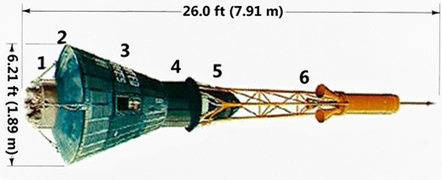





![The control panels of Friendship 7.[91] The panels changed between flights, among others the periscope screen that dominates the center of these panels was dropped for the final flight together with the periscope itself.](http://upload.wikimedia.org/wikipedia/commons/thumb/8/8b/Control_panels_mercury_atlas_6.png/271px-Control_panels_mercury_atlas_6.png)




![Drop of boilerplate spacecraft in training of landing and recovery. 56 such qualification tests were made together with tests of individual steps of the system.[44]](http://upload.wikimedia.org/wikipedia/commons/thumb/e/e4/Mercury-project-earth-landing-system-test.png/235px-Mercury-project-earth-landing-system-test.png)




![Mercury 7 astronaut assignments. Schirra had the most flights with three; Glenn, though being the first to leave NASA, had the last with a Space Shuttle mission in 1998.[154] Shepard was the only one to walk on the Moon.](http://upload.wikimedia.org/wikipedia/commons/thumb/1/1f/AstronautAssignmentsChart-Mercury7.PNG/391px-AstronautAssignmentsChart-Mercury7.PNG)


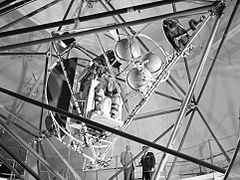



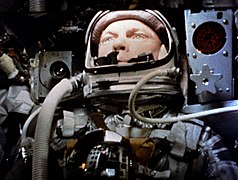




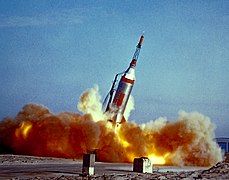


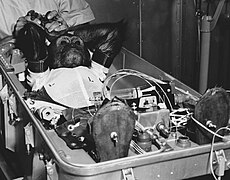

![Commemorative Project Mercury 4¢ US Postage stamp[n 46]](http://upload.wikimedia.org/wikipedia/commons/thumb/b/ba/Project_Mercury_4%C2%A2_US_Postage_stamp_February_20%2C_1962_FDC_Scott_-1193.jpg/329px-Project_Mercury_4%C2%A2_US_Postage_stamp_February_20%2C_1962_FDC_Scott_-1193.jpg)
